Being measured!
-
schneidergott
- Posts: 149
- Joined: Mon Jul 09, 2007 8:13 pm
- Location: Castle Douglas, Scotland
Last edited by schneidergott on Fri Mar 26, 2010 7:56 pm, edited 1 time in total.
Herr Schneidergott
Vielen dank!
Great post and a very helpful one
Michael
Vielen dank!
Great post and a very helpful one
Michael
Armscye Depth
I find it interesting that this particular text recommends adding 2-3cm to the depth of scye. Most texts I own do not say to do this, and add the depth of scye as measured directly to the draft.
Most textbooks don't bother to mention what happens to the scye during the making up process. However, in the case of Devere 1866, he adds the depth of scye directly to the draft without room for seam allowances or added ease. He does make it clear that stretching of the front of the scye during the making up will stretch the circumference of the scye by 3/4" (1.9cm), which should add a little ease to the armscye. Die Zuschneidekunst has one diagram in which the front of scye is fulled (clearly marked "einschränken") rather than stretched, in which case more ease may have to be permitted on the draft.
Another point is that the depth of scye as measured from the front going from neck point to the base of arm scye is often called the "strap".
This is how the strap measurement is taken (from a to b):
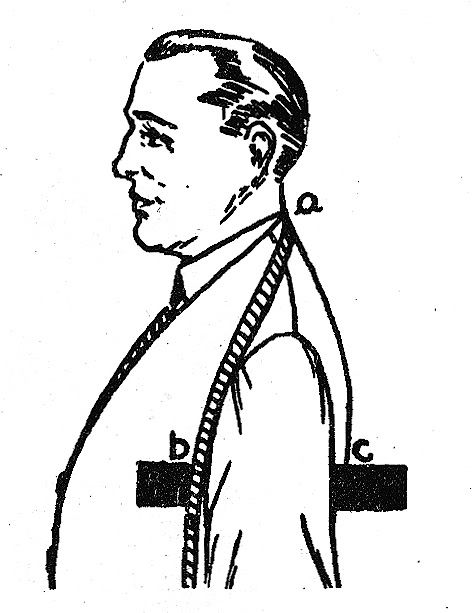
A ruler is held jammed up horizontally underneath the armpit, and a tape measure is held tight from the neck point to top edge of the ruler measure going from a to b.
In order to apply the strap, the half width of back neck seam has to be subtracted from the strap. This measure is marked from B to W on the following draft:

The strap measure can then be applied. The full strap measure goes from W to point X, but the depth of scye goes from B to X:

I hope "a tailor" doesn't mind me borrowing his diagram (he borrowed mine too). Slightly modified version of the one posted here:
http://www.askandyaboutclothes.com/foru ... post859554
This is the other way of measuring armscye depth measuring a to b from behind:

To measure this, a tape measure is held under the armpits across the back. A chalk mark or pin is placed to mark where the top of the tape measure intersects the centre back seam:
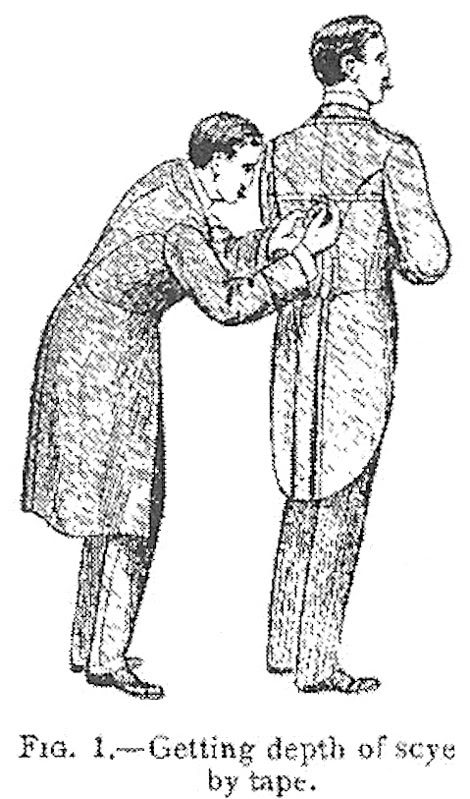
Measure from the neck point to the mark:
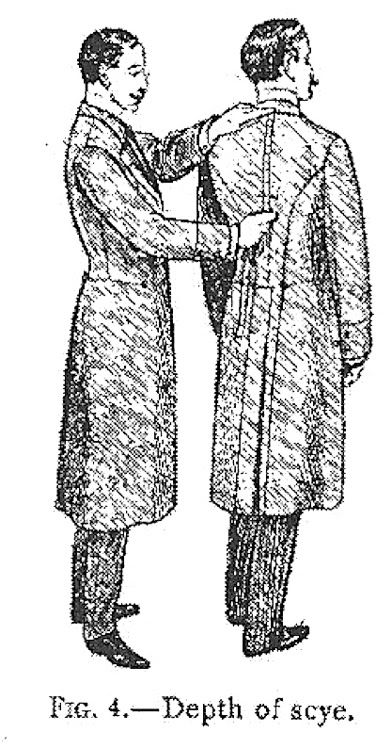
Next, is the question of whether to use the strap measure or the arm scye depth from behind to determine the armscye depth on the coat. This usually doesn't matter that much, unless, during the making up, the neck point is going to be crookened as shown in the next diagram. The "correct" neck point is 9 1/2" from point "0" (top right). However, in figure 5, the coat is cut too straight and the neck point needs to be manipulated ("crookened") from the 10 1/4" mark to the 9 1/2" mark.

Notice that the strap measure has been applied to determine the depth of scye. The strap is less liable to be changed significantly by manipulation of the neck point than is the depth of scye measured from behind.
Personally, it is my belief that measurements should be taken in more than one way, if possible. Taking multiple seemingly redundant measurements helps to improve accuracy. That's why I like the idea of adding a depth of scye measurement from both front and behind.
Next time I will discuss Devere's system of measurement - even though I risk being thought of having an obsession with his book . He has another way of double checking a lot of measurements but the fundamentals of his whole system have to be explained.
. He has another way of double checking a lot of measurements but the fundamentals of his whole system have to be explained.
I find it interesting that this particular text recommends adding 2-3cm to the depth of scye. Most texts I own do not say to do this, and add the depth of scye as measured directly to the draft.
Most textbooks don't bother to mention what happens to the scye during the making up process. However, in the case of Devere 1866, he adds the depth of scye directly to the draft without room for seam allowances or added ease. He does make it clear that stretching of the front of the scye during the making up will stretch the circumference of the scye by 3/4" (1.9cm), which should add a little ease to the armscye. Die Zuschneidekunst has one diagram in which the front of scye is fulled (clearly marked "einschränken") rather than stretched, in which case more ease may have to be permitted on the draft.
Another point is that the depth of scye as measured from the front going from neck point to the base of arm scye is often called the "strap".
This is how the strap measurement is taken (from a to b):

A ruler is held jammed up horizontally underneath the armpit, and a tape measure is held tight from the neck point to top edge of the ruler measure going from a to b.
In order to apply the strap, the half width of back neck seam has to be subtracted from the strap. This measure is marked from B to W on the following draft:

The strap measure can then be applied. The full strap measure goes from W to point X, but the depth of scye goes from B to X:

I hope "a tailor" doesn't mind me borrowing his diagram (he borrowed mine too). Slightly modified version of the one posted here:
http://www.askandyaboutclothes.com/foru ... post859554
This is the other way of measuring armscye depth measuring a to b from behind:

To measure this, a tape measure is held under the armpits across the back. A chalk mark or pin is placed to mark where the top of the tape measure intersects the centre back seam:

Measure from the neck point to the mark:

Next, is the question of whether to use the strap measure or the arm scye depth from behind to determine the armscye depth on the coat. This usually doesn't matter that much, unless, during the making up, the neck point is going to be crookened as shown in the next diagram. The "correct" neck point is 9 1/2" from point "0" (top right). However, in figure 5, the coat is cut too straight and the neck point needs to be manipulated ("crookened") from the 10 1/4" mark to the 9 1/2" mark.

Notice that the strap measure has been applied to determine the depth of scye. The strap is less liable to be changed significantly by manipulation of the neck point than is the depth of scye measured from behind.
Personally, it is my belief that measurements should be taken in more than one way, if possible. Taking multiple seemingly redundant measurements helps to improve accuracy. That's why I like the idea of adding a depth of scye measurement from both front and behind.
Next time I will discuss Devere's system of measurement - even though I risk being thought of having an obsession with his book
-
schneidergott
- Posts: 149
- Joined: Mon Jul 09, 2007 8:13 pm
- Location: Castle Douglas, Scotland
Last edited by schneidergott on Fri Mar 26, 2010 7:57 pm, edited 1 time in total.
Quite true. I have posted these images before:
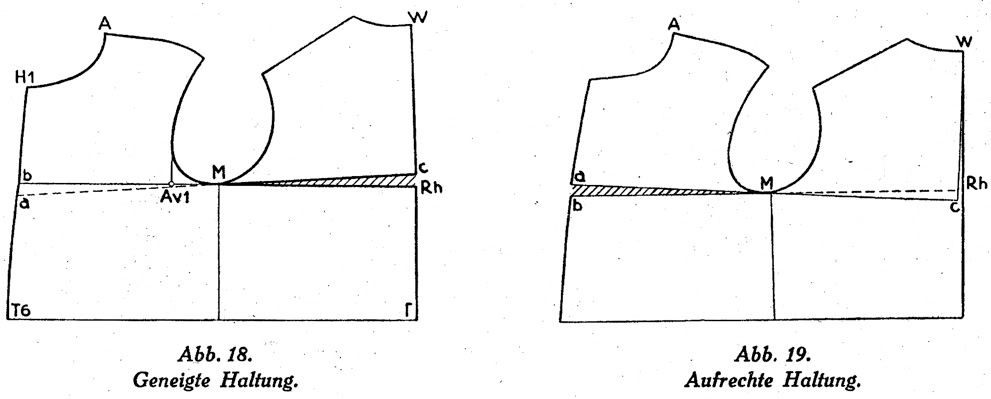
It shows how these measurements change depending on the posture of the person.
On the left is someone with a stooped posture (figure 18). On the right is someone with an erect posture (figure 19).
This is a draft with the strap and depth of scye incorporated into it:
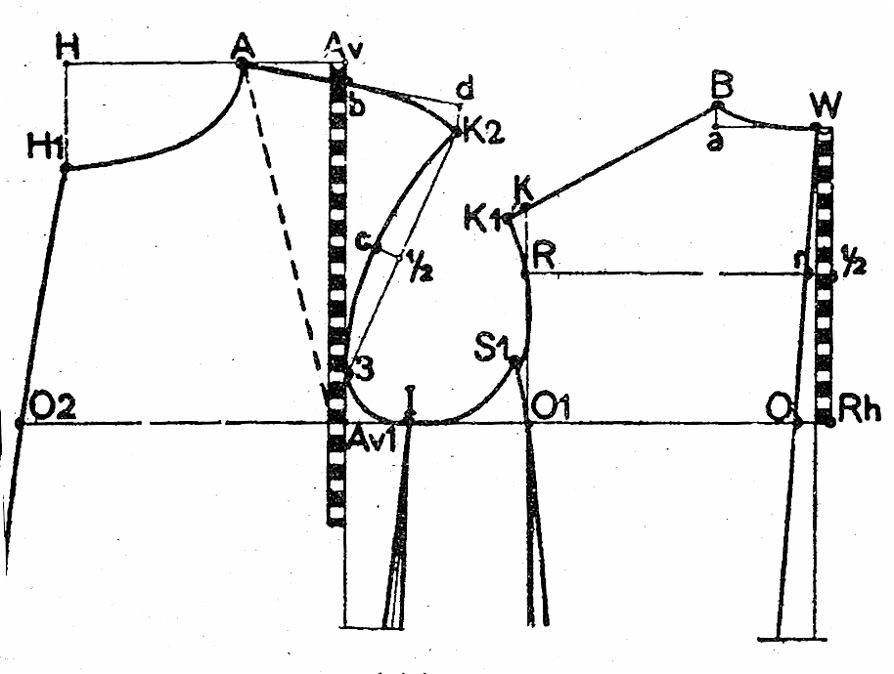
W to Rh is the depth of scye. Av to Av1 is derived as previously described from the front strap measurement.
These were all taken from die Zuschneidekunst.
While the use of the strap and depth of scye over the back is one way to incorporate measures of balance into a draft Devere has a highly innovative way of taking and incorporating measures of balance into his drafting system, which I personally prefer.

It shows how these measurements change depending on the posture of the person.
On the left is someone with a stooped posture (figure 18). On the right is someone with an erect posture (figure 19).
This is a draft with the strap and depth of scye incorporated into it:

W to Rh is the depth of scye. Av to Av1 is derived as previously described from the front strap measurement.
These were all taken from die Zuschneidekunst.
While the use of the strap and depth of scye over the back is one way to incorporate measures of balance into a draft Devere has a highly innovative way of taking and incorporating measures of balance into his drafting system, which I personally prefer.
-
luk-cha
i was just wondering, how does one meassure the rise on trousers, both the front rise and the rear rise?
this would be for a lower/ modern rise also i higher more classical rise!
thanks!
this would be for a lower/ modern rise also i higher more classical rise!
thanks!
-
schneidergott
- Posts: 149
- Joined: Mon Jul 09, 2007 8:13 pm
- Location: Castle Douglas, Scotland
Last edited by schneidergott on Fri Mar 26, 2010 7:58 pm, edited 1 time in total.
-
Jovan the Un1337
- Posts: 81
- Joined: Tue Feb 13, 2007 1:54 am
- Location: Florida
- Contact:
Just me, or does the man in the photographs look utterly bored? Like, "Okay, let's get these pictures over with..." 
-
misterjase
I would be interested in this. I presume that a system so complex would require a lot of measurements.Sator wrote:Next time I will discuss Devere's system of measurement. He has another way of double checking a lot of measurements but the fundamentals of his whole system have to be explained.
Having some familiarity with DeVere's system, I'll take a crack at this.I would be interested in this. I presume that a system so complex would require a lot of measurements.
DeVere's measurements for a coat draft are shown here:

These are divided into three series. The first six (breast, waist, curve, bust, side, and scye depth) are basic sizes and widths. The next six (back, skirt, back width, sleeve length, elbow, and wrist) size the back and sleeves. The last six (back stretch, scye diameter, front of scye, chest, shoulder slope, and round of scye) are "check measures" and may be used to account for disproportion.
The unique feature of DeVere's system is the "centre point" (look at the waist seam of the forepart in Fig. 4). DeVere proposed this as a "centre of gravity" for the human figure. It is located 2/5 of DeVere's "waist" (or 1/5 of the full, measured waist) around the waistline from center back. It serves as a common reference point for the curve, bust and side measures (see Fig 1).
DeVere defines "balance" as the difference between the "bust" and "curve" measures, which are measured between the same two points but over the front and back of the body respectively. He uses this measure to define figuration; a stooping man's coat will be cut with a shorter balance; an "erect" man will have a longer balance. While the principle is correct experience shows the "bust" measure is very hard to take accurately and consistently. It can be thrown off by the client's posture, a well-built or padded chest, or large shoulders. Judging the "balance" by observation of the client's posture and calculating the "bust" by adding it to the "curve" has been more successful in my case.
Getting back to the original question, the depth of scye can be found by measuring up from the centre point (No. 5. "side"), or measuring down from the middle of the collar seam (No. 6, "depth"), which also serves as a check.
Hope this is of interest,
Jim Ruley
-
misterjase
Thanks for that. Good stuff.
But I find it difficult to get a feel for the measurements that are taken by a tailor on a person.
Would it be possible to translate the measurements on the fabric to the measurements on a person for me.
But I find it difficult to get a feel for the measurements that are taken by a tailor on a person.
Would it be possible to translate the measurements on the fabric to the measurements on a person for me.
-
- Information
-
Who is online
Users browsing this forum: couch and 8 guests
